OpenStack VPS And Cloud For WHMCS
| Line 120: | Line 120: | ||
|style="padding: 0px 0px 30px 25px;"|[[File:OSV4.png]] | |style="padding: 0px 0px 30px 25px;"|[[File:OSV4.png]] | ||
|} | |} | ||
| − | |||
==Configuration of Server== | ==Configuration of Server== | ||
{| | {| | ||
| − | |style="padding: 10px 0px 15px 15px;"|'''5. Now, we will show you how to configure a new product.''' <br /> | + | |style="padding: 10px 0px 15px 15px;"|'''5. Now, we will show you how to configure a new product.'''<br /> |
Go to the '' 'Setup' '' → '' 'Products/Services' '' → '' 'Servers' '' and press '' 'Add New Server' ''. | Go to the '' 'Setup' '' → '' 'Products/Services' '' → '' 'Servers' '' and press '' 'Add New Server' ''. | ||
|} | |} | ||
| Line 130: | Line 129: | ||
|} | |} | ||
{| | {| | ||
| − | |style="padding: 0px 0px | + | |style="padding: 0px 0px 15px 15px;"|'''6. Next, enter your server name, IP address/hostname, username, password and admin tenant ID.'''<br /> |
Choose '' 'OpenStackVPS' '' from a dropdown menu and press '' 'Save Changes' ''.''' | Choose '' 'OpenStackVPS' '' from a dropdown menu and press '' 'Save Changes' ''.''' | ||
|} | |} | ||
| Line 137: | Line 136: | ||
|} | |} | ||
{| | {| | ||
| − | |style="padding: 0px 0px 15px 15px;"|'''7. After you configure your server correctly, you will see a following screen.''' <br /> | + | |style="padding: 0px 0px 15px 15px;"|'''7. After you configure your server correctly, you will see a following screen.'''<br /> |
You can check connection with OpenStack server, simply edit previously created server and press '' 'Test Connection' '' as shown on the screen below. | You can check connection with OpenStack server, simply edit previously created server and press '' 'Test Connection' '' as shown on the screen below. | ||
|} | |} | ||
| Line 159: | Line 158: | ||
{| | {| | ||
|style="padding: 10px 0px 15px 15px;"|'''10. In order to create and configure a product go to the '' 'Setup' '' → '' 'Products/Services' '' → '' 'Products/Services' ''.'''<br /> | |style="padding: 10px 0px 15px 15px;"|'''10. In order to create and configure a product go to the '' 'Setup' '' → '' 'Products/Services' '' → '' 'Products/Services' ''.'''<br /> | ||
| − | Click on '' 'Create a New Group' ''. | + | Click on '' 'Create a New Group' ''. |
|} | |} | ||
{| | {| | ||
| Line 194: | Line 193: | ||
==VPS With Predefined Resources== | ==VPS With Predefined Resources== | ||
{| | {| | ||
| − | |style="padding: | + | |style="padding: 10px 0px 15px 15px;"|Our module allows you to offer OpenStack VPS to your client in two ways: with predefined resources and configurable resources.<br /> |
In this section we will show you configuration of VPS with predefined resources.<br /> | In this section we will show you configuration of VPS with predefined resources.<br /> | ||
Configuration of VPS with resources chosen by client can be found [http://www.docs.modulesgarden.com/OpenStack_VPS_For_WHMCS#VPS_With_Configurable_Resources here]. | Configuration of VPS with resources chosen by client can be found [http://www.docs.modulesgarden.com/OpenStack_VPS_For_WHMCS#VPS_With_Configurable_Resources here]. | ||
|} | |} | ||
{| | {| | ||
| − | |style="padding: 0px 0px 15px 15px;"|'''15. Start from selecting '' 'Default Tenant' '', '' 'Default Flavor' '' and '' 'Default ISO Image' ''. ''' | + | |style="padding: 0px 0px 15px 15px;"|'''15. Start from selecting '' 'Default Tenant' '', '' 'Default Flavor' '' and '' 'Default ISO Image' ''.''' |
|} | |} | ||
{| | {| | ||
| Line 214: | Line 213: | ||
{| | {| | ||
|style="padding: 0px 0px 15px 15px;"|'''17. Finish through selecting features available at the client area.'''<br /> | |style="padding: 0px 0px 15px 15px;"|'''17. Finish through selecting features available at the client area.'''<br /> | ||
| − | Mark checkbox next to | + | Mark checkbox next to a feature to enable it. Press '' 'Save Changes' '' when you are done. |
| + | |} | ||
| + | {| | ||
| + | |style="padding: 0px 0px 20px 25px;"|[[File:OSV17.png]] | ||
|} | |} | ||
{| | {| | ||
| − | |style="padding: 0px 0px 30px | + | |style="padding: 0px 0px 30px 15px;"|'''Congratulations! You have just finished the installation and configuration of the module with predefined resources.''' |
|} | |} | ||
==VPS With Configurable Resources== | ==VPS With Configurable Resources== | ||
{| | {| | ||
| − | |style="padding: | + | |style="padding: 10px 0px 15px 15px;"|'''15. Preparing VPS with configurable options starts of pressing '' 'Generate default' '' as shown on the following screen.'''<br /> |
It will prepare default configurable options which can be afterwards easily edited by you based on [http://www.docs.modulesgarden.com/General#How_To_Use_Configurable_Options this article]. | It will prepare default configurable options which can be afterwards easily edited by you based on [http://www.docs.modulesgarden.com/General#How_To_Use_Configurable_Options this article]. | ||
|} | |} | ||
| Line 229: | Line 231: | ||
|} | |} | ||
{| | {| | ||
| − | |style="padding: 0px 0px 15px 15px;"|''' | + | |style="padding: 0px 0px 15px 15px;"|'''16. Afterwards, it is time to set up a network. Choose '' 'Fixed Network' '', '' 'Floating Network' '' and '' 'Default Number Of IP Addresses' ''.'''<br /> |
You can set up network in two ways, more about them you can find [http://www.docs.modulesgarden.com/OpenStack_VPS_For_WHMCS#Network_Configuration_Cases here].<br /> | You can set up network in two ways, more about them you can find [http://www.docs.modulesgarden.com/OpenStack_VPS_For_WHMCS#Network_Configuration_Cases here].<br /> | ||
On the following screen I will set up a network without floating IP address. | On the following screen I will set up a network without floating IP address. | ||
| Line 237: | Line 239: | ||
|} | |} | ||
{| | {| | ||
| − | |style="padding: 0px 0px 15px 15px;"|''' | + | |style="padding: 0px 0px 15px 15px;"|'''17. Finish through selecting features available at the client area.'''<br /> |
Mark checkbox next to the feature to enable it. Press '' 'Save Changes' '' when you are done. | Mark checkbox next to the feature to enable it. Press '' 'Save Changes' '' when you are done. | ||
|} | |} | ||
{| | {| | ||
| − | |style="padding: 0px 0px | + | |style="padding: 0px 0px 20px 25px;"|[[File:OSV20.png]] |
|} | |} | ||
{| | {| | ||
| − | |style="padding: 0px 0px 30px 15px;"|'''Congratulations! You have just finished the installation and configuration of the module.''' | + | |style="padding: 0px 0px 30px 15px;"|'''Congratulations! You have just finished the installation and configuration of the module with configurable resources.''' |
|} | |} | ||
| Line 275: | Line 277: | ||
===noVNC Console=== | ===noVNC Console=== | ||
{| | {| | ||
| − | |style="padding: 10px 0px 15px 15px;"|One of the most interesting functionality is a noVNC console | + | |style="padding: 10px 0px 15px 15px;"|One of the most interesting functionality is a noVNC console where your client can remotely manage server. To access it, simply press on the '' 'Console' '' button.<br /> |
Console requires Java software. You need to accept security risk to run it. | Console requires Java software. You need to accept security risk to run it. | ||
|} | |} | ||
| Line 281: | Line 283: | ||
|style="padding: 0px 0px 30px 25px;"|[[File:OSV28.png]] | |style="padding: 0px 0px 30px 25px;"|[[File:OSV28.png]] | ||
|} | |} | ||
| − | |||
===Backups=== | ===Backups=== | ||
{| | {| | ||
| Line 313: | Line 314: | ||
{| | {| | ||
|style="padding: 0px 0px 15px 15px;"|Second type of network is a network with floating IP address.<br /> | |style="padding: 0px 0px 15px 15px;"|Second type of network is a network with floating IP address.<br /> | ||
| − | Select '' | + | Select '' 'Shared Network' '' as '' 'Fixed Network' '' and '' 'Public' '' as '' 'Floating network' ''. |
|} | |} | ||
{| | {| | ||
Revision as of 13:08, 27 March 2014
Contents |
About OpenStack VPS For WHMCS
| OpenStack VPS For WHMCS is a powerful module which allows you to automatically provision virtual servers to your customers. Additionally it allows you to conveniently manage your servers. |
- Module Features:
| ✔ Configuration Of Backups Quantity Limit |
| ✔ Triggerable Routing Backups (Newest Backup Overwrites The Oldest One If Backup Limit Is Reached) |
| ✔ Configuration Of Client Area Features |
| ✔ Configurable Options (Flavor, VM Image, IP Addresses, Backups Files Limit, Disk, RAM and VCPUs) |
- Admin Area Features:
| ✔ Create Server |
| ✔ Suspend/Unsuspend Server |
| ✔ Terminate Server |
| ✔ Change Package (Supports Configurable Options) |
| ✔ View Server Status And Details |
| ✔ View Interface Details |
| ✔ View List Of Cron Jobs |
- Client Area Features:
| ✔ View Server Status And Details |
| ✔ Start/Stop Server |
| ✔ Pause/Unpause Server |
| ✔ Resume Server |
| ✔ Soft Reboot Server |
| ✔ Hard Reboot Server |
| ✔ Reset Network |
| ✔ Rebuild |
| ✔ noVNC Console |
| ✔ Backups |
| ✔ View List Of Cron Jobs |
- Additionally:
| ✔ Multi-Language Support |
| ✔ Supports WHMCS V5 and Later |
Installation and Configuration
| This tutorial will show you how to successfully install and configure OpenStack VPS For WHMCS. We will guide you step by step through the whole installation and configuration process. |
Installation
| 1. Log in to your client area and download OpenStack VPS For WHMCS. |
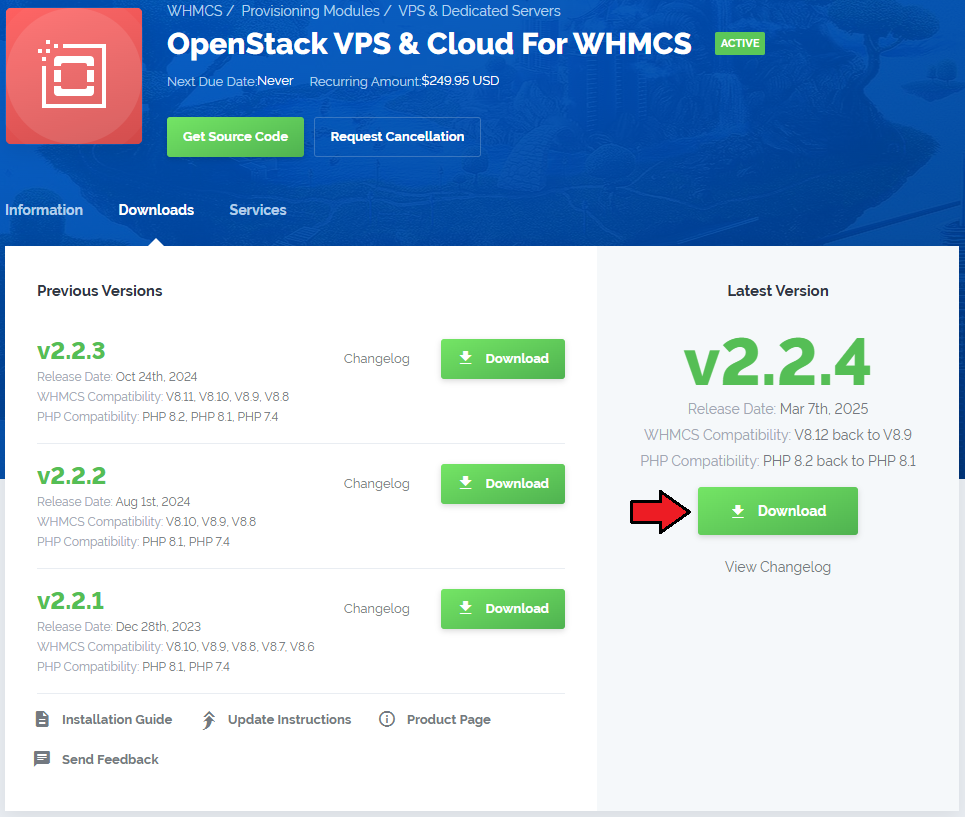
|
| 2. Upload and extract the module into the main WHMCS directory. |

|
| 3. When you install OpenStack VPS for the first time you have to rename 'license_RENAME.php' file. File is located at 'modules/servers/OpenStackVPS/license_RENAME.php' . Rename it from 'license_RENAME.php' to 'license.php' . |
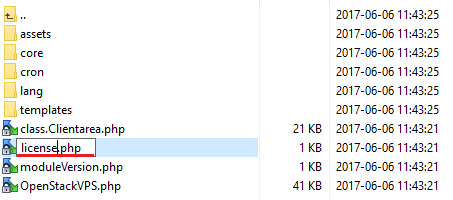
|
| 4. In order to configure your license key, you have to edit a previously renamed 'license.php' file. Enter your license key between quotation marks as presented on the following screen. |

|
Configuration of Server
| 5. Now, we will show you how to configure a new product. Go to the 'Setup' → 'Products/Services' → 'Servers' and press 'Add New Server' . |
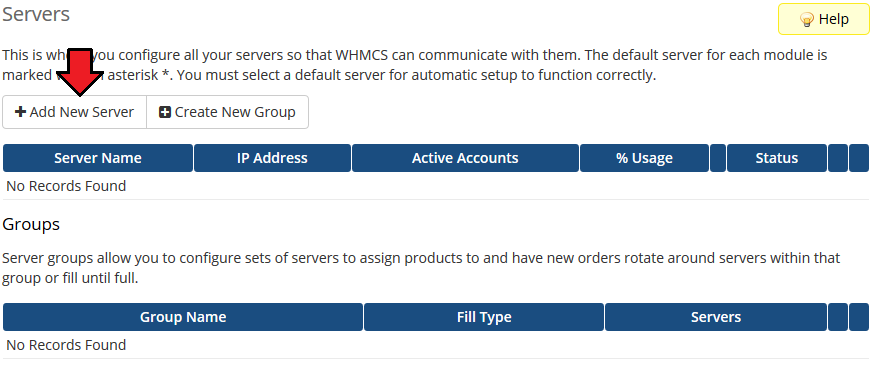
|
| 6. Next, enter your server name, IP address/hostname, username, password and admin tenant ID. Choose 'OpenStackVPS' from a dropdown menu and press 'Save Changes' . |
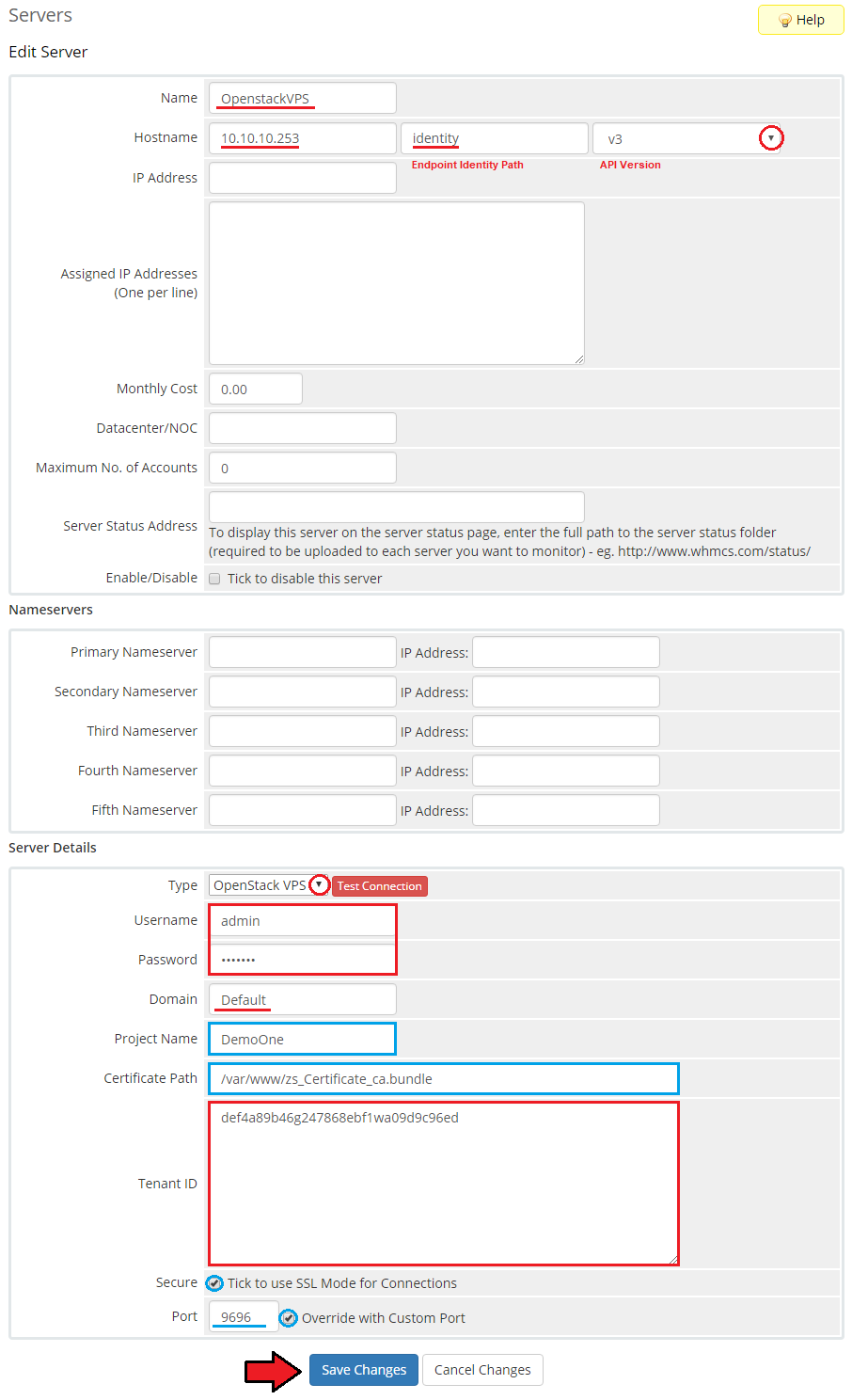
|
| 7. After you configure your server correctly, you will see a following screen. You can check connection with OpenStack server, simply edit previously created server and press 'Test Connection' as shown on the screen below. |
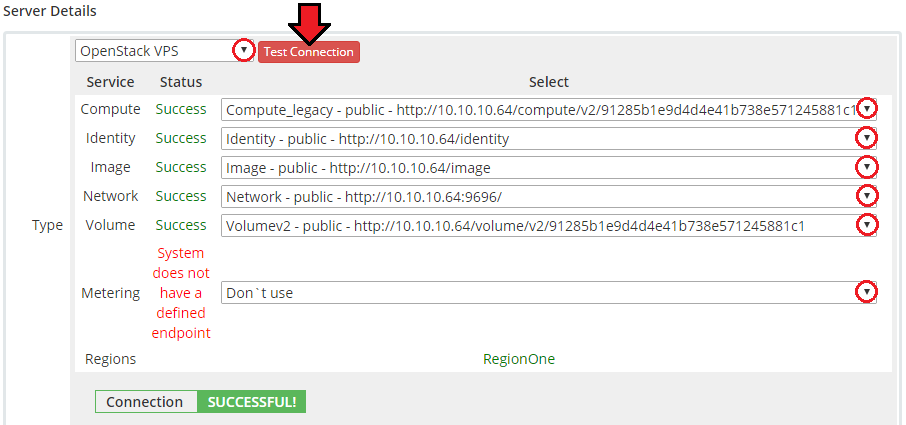
|
| 8. It is time to create a server group. To do so, click on a 'Create Server Group' . |
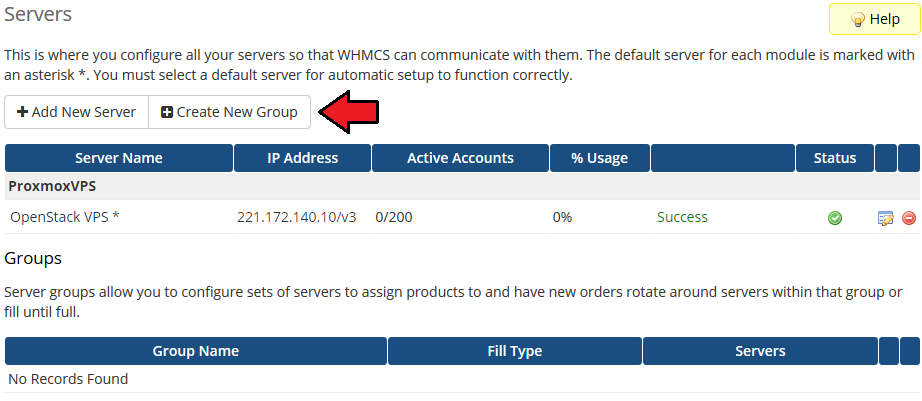
|
| 9. Enter name, click on your previously created server, press an 'Add' and afterwards a 'Save Changes' . |
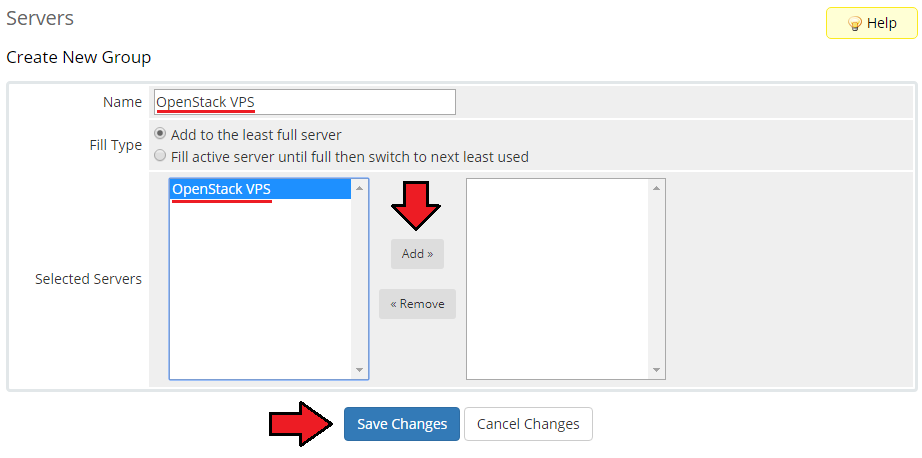
|
Configuration of Product
| 10. In order to create and configure a product go to the 'Setup' → 'Products/Services' → 'Products/Services' . Click on 'Create a New Group' . |

|
| 11. Enter product group name and press 'Save Changes' . |
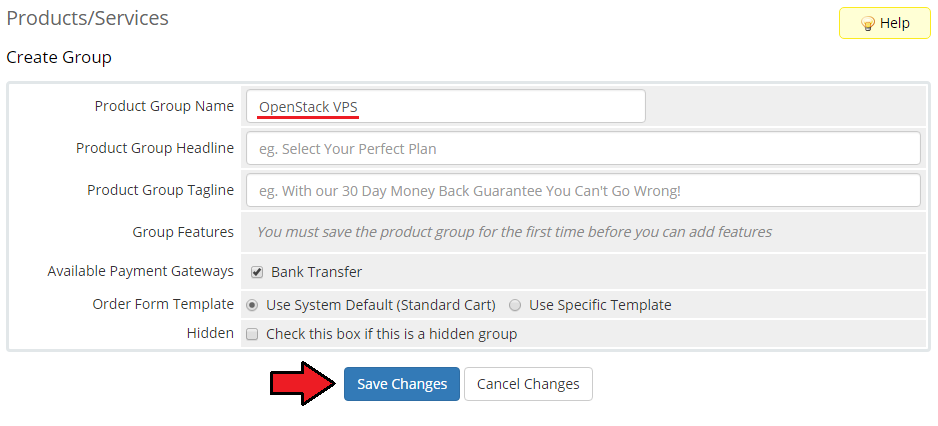
|
| 12. When you have a product group, you can create your product. To create a product click on 'Create a New Product' . |

|
| 13. Afterwards, choose your product group and type from dropdown menus, enter your product name and press 'Continue' . 'Product Type' should be set to 'Dedicated/VPS Server' . |

|
| 14. Now, go to the 'Module Settings' section, choose both 'OpenStackVPS' and your previously created server group from dropdown menus. Next, click on 'Save Changes' . |
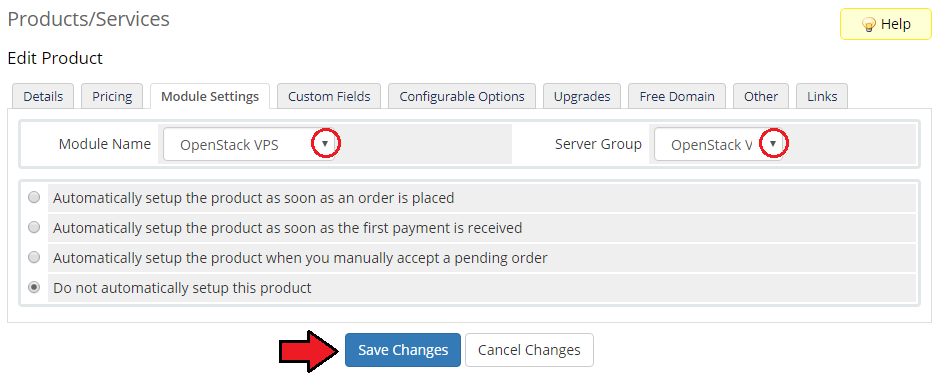
|
VPS With Predefined Resources
| Our module allows you to offer OpenStack VPS to your client in two ways: with predefined resources and configurable resources. In this section we will show you configuration of VPS with predefined resources. |
| 15. Start from selecting 'Default Tenant' , 'Default Flavor' and 'Default ISO Image' . |
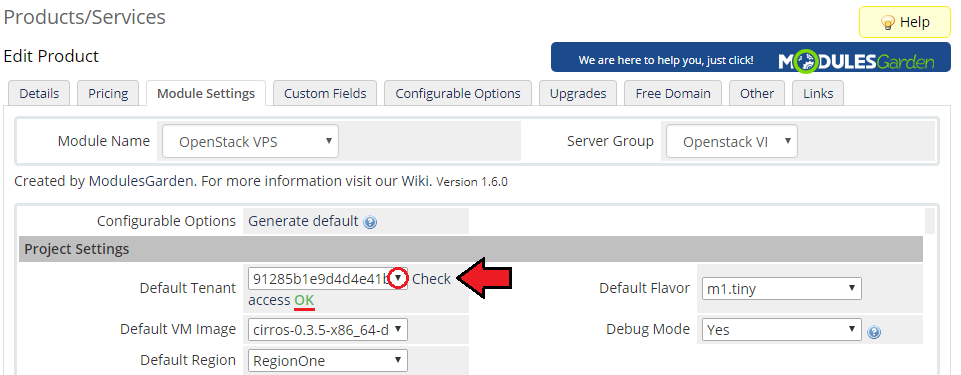
|
| 16. Afterwards, it is time to set up a network. Choose 'Fixed Network' , 'Floating Network' and 'Default Number Of IP Addresses' . You can set up network in two ways, more about them you can find here. |

|
| 17. Finish through selecting features available at the client area. Mark checkbox next to a feature to enable it. Press 'Save Changes' when you are done. |

|
| Congratulations! You have just finished the installation and configuration of the module with predefined resources. |
VPS With Configurable Resources
| 15. Preparing VPS with configurable options starts of pressing 'Generate default' as shown on the following screen. It will prepare default configurable options which can be afterwards easily edited by you based on this article. |

|
| 16. Afterwards, it is time to set up a network. Choose 'Fixed Network' , 'Floating Network' and 'Default Number Of IP Addresses' . You can set up network in two ways, more about them you can find here. |
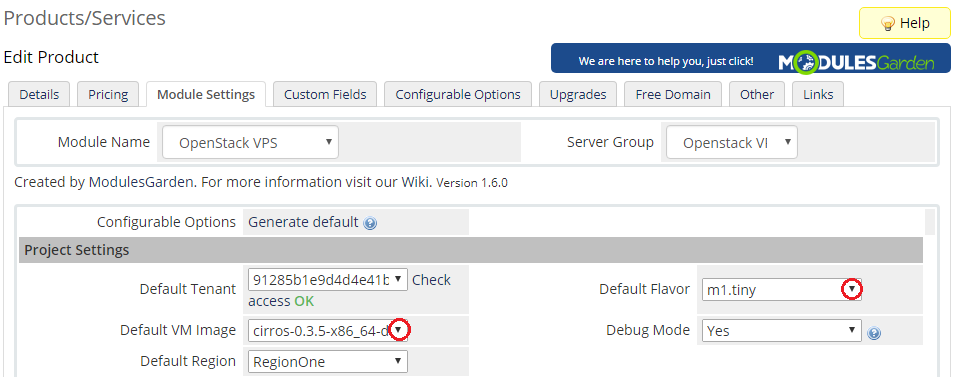
|
| 17. Finish through selecting features available at the client area. Mark checkbox next to the feature to enable it. Press 'Save Changes' when you are done. |
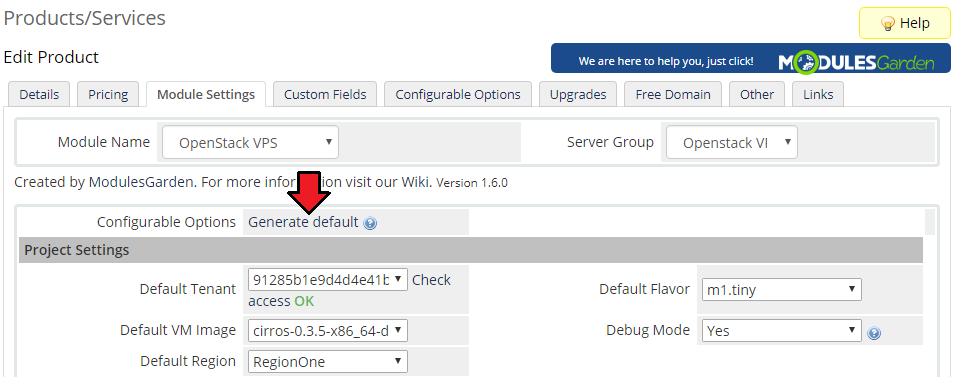
|
| Congratulations! You have just finished the installation and configuration of the module with configurable resources. |
Management
| OpenStack VPS For WHMCS allows your customers to manage their OpenStack VPS via client area in your WHMCS system. You can monitor and manage each product from your WHMCS admin area. |
| File:OSV23 5.png |
Client Area
| Client area interface of OpenStack VPS should look like the one on the screen below. As you can see, control panel contain useful options needed for managing VPS. Module allows your customer to easily start/stop, pause/unpause, resume, soft reboot, hard reboot and reset network of his server through pressing specified button. |
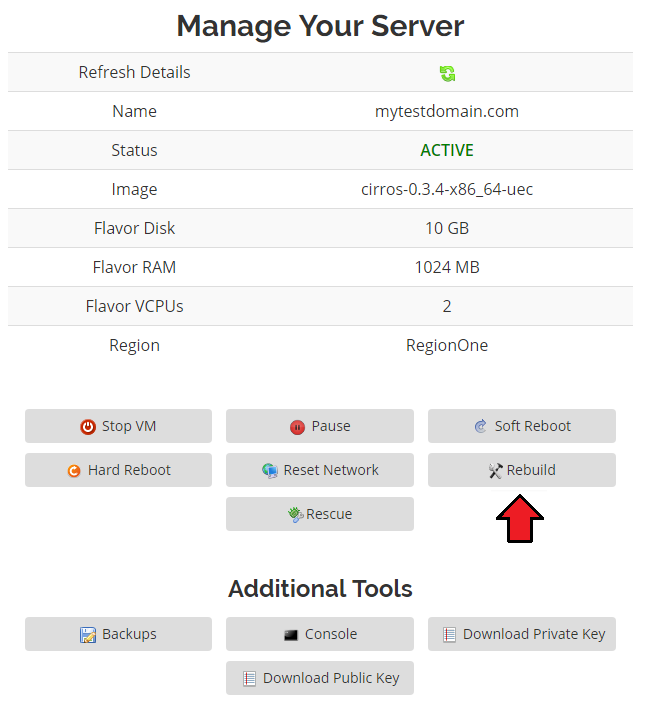
|
Rebuild
| Rebuild feature allows to change server image. To reinstall your server, choose an image and root password. Afterwards, confirm through clicking on 'Reinstall' (5) button. |
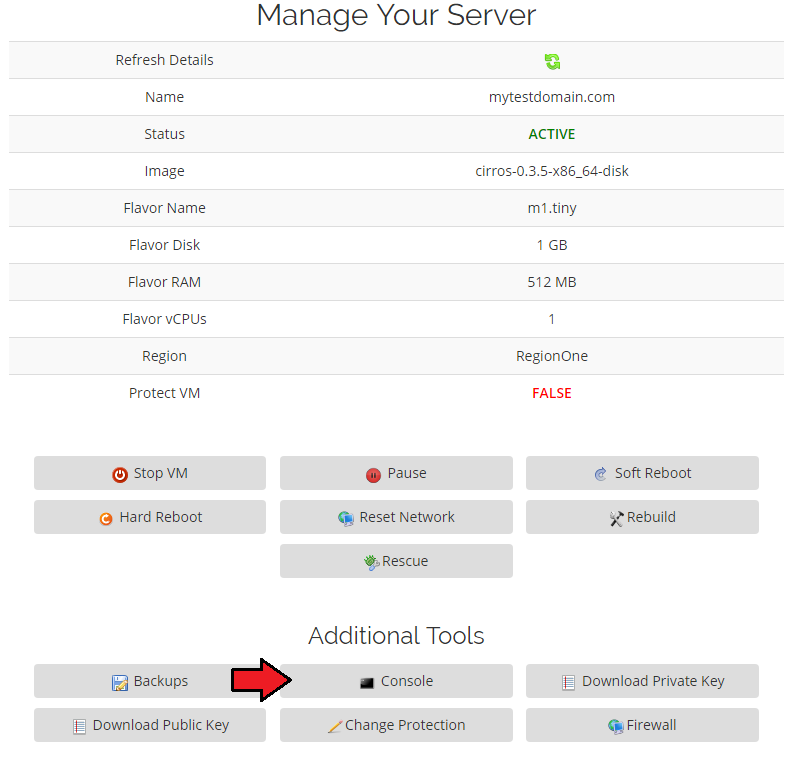
|
noVNC Console
| One of the most interesting functionality is a noVNC console where your client can remotely manage server. To access it, simply press on the 'Console' button. Console requires Java software. You need to accept security risk to run it. |
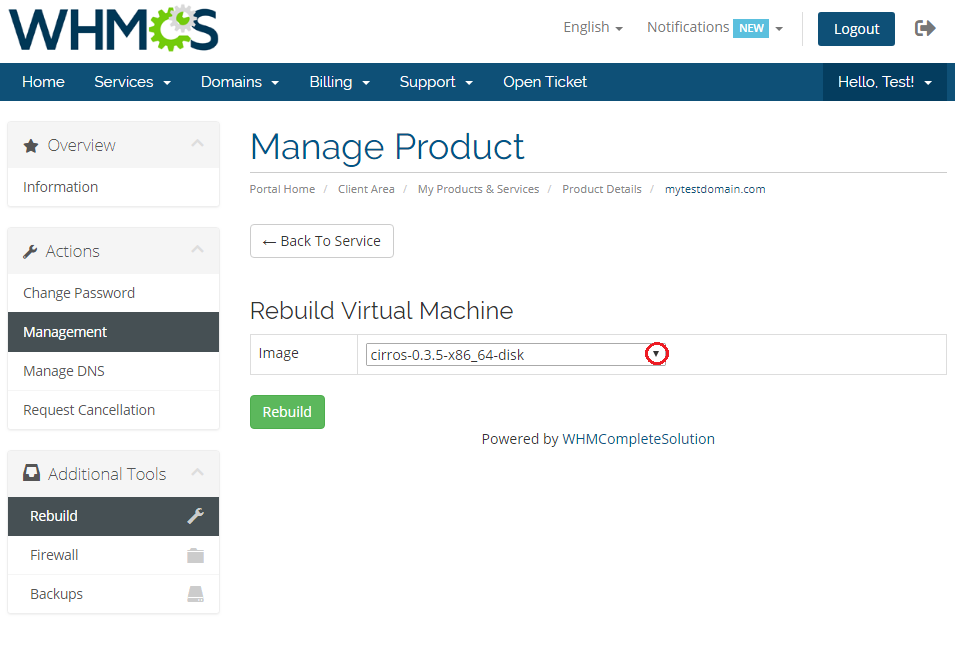
|
Backups
| You can also create a backup of VPS. To do so, press 'Backups' button. |
| File:OSV31 2.png |
| Now, choose backup name and press 'Backup Now' button. |
| File:OSV31 3.png |
| To restore VPS from backup simply press 'Restore' next to it. |
| File:OSV31 4.png |
Network Configuration Cases
| OpenStack VPS For WHMCS allows you to set up two types of network. First one is network without floating IP address. To set up this type of network, choose 'Public' as 'Fixed Network' and 'Disabled' as 'Floating Network' . |
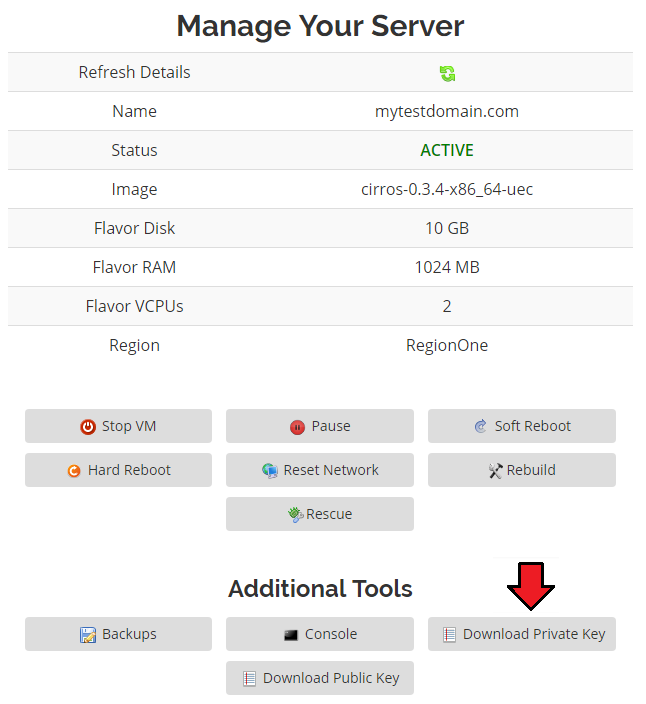
|
| Second type of network is a network with floating IP address. Select 'Shared Network' as 'Fixed Network' and 'Public' as 'Floating network' . |
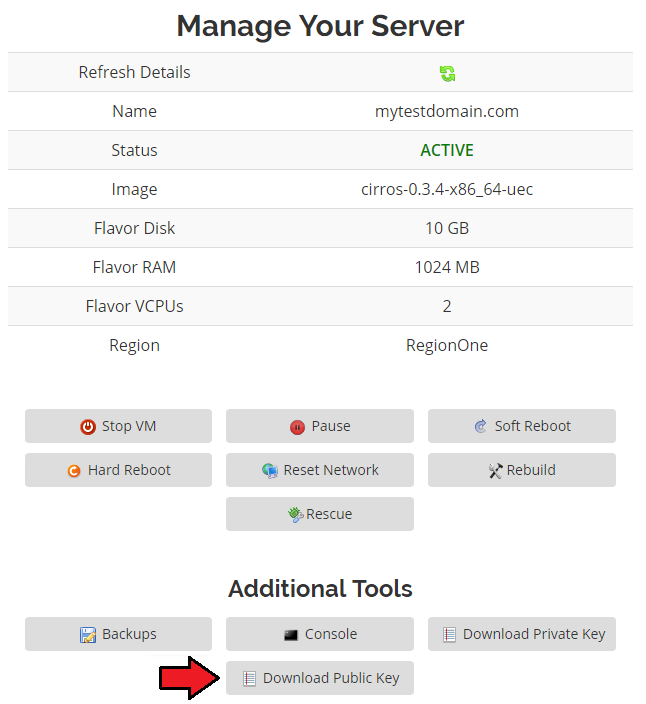
|
Tips
Common Problems
| 1. When you have problems with connection, check whether your SELinux or firewall is not blocking ports. |